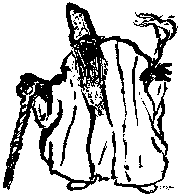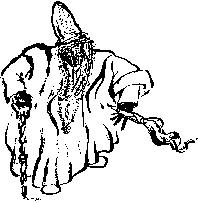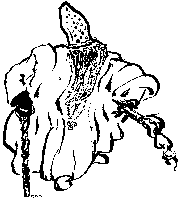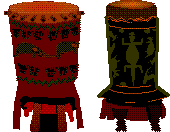
© 1995 Al Crichton
Program notes and graphics

Program notes and graphics
 and down in the other:
and down in the other:

The drawing at the top of the page is perhaps a little scary. These drawings are by the artist Alan Crichton, who is happy to have you use them if you will be sure to send us a copy and if you include a copyright notice. It should say "© 1995 Al Crichton " like it does at the top.
In your program you should list the Title of the dance, the Country the dance is from, and the performers, followed by a brief description of the dance. The dance of Obatala is from Nigeria and is usually done as a solo by Arthur Hall, so your program might look like this:
OBATALA ~ Nigeria ~ Arthur Hall (with nice spacing)There is a lot more information about Obatala, but it is always good to keep program notes brief.
Obatala means "King of the White Cloth." He is the creation deity of the Yoruba people, the blank canvas of creativity. He creates, and God blows the breath of life into Obatala's creations. [Costume]
DANCE OF WELCOME ~ Sierra Leone ~ Mr. Y's xth Grade Class (e.g.)You can decorate the program with drawings. Here are a couple of drums:
The people of Sierra Leone consider it an honor to be visited. They adorn themselves in their finest clothes to dance for their guests. [Costume]FANGA ~ Liberia
Mrs. T's nth Grade Class (for another example)
"We welcome you from our hearts whether you are from the North, South, East, or West." Performed to welcome the New Year, new born babies, returning soldiers, and visitors. [Costume]OLOKUN ~ Nigeria
Ms.R's Zth Grade Class (last example, you get the idea)
Olokun is the Yoruba deity of the undertow. The children sing "Don't go near the water if you can't swim. The undertow will take you away." [Costume]HARVEST DANCE ~ Ghana ~ Mrs.etc.'s
The god of the Harvest furrows through the soil, digs holes with one foot, and covers them with the other. Seeds are sown, the rain falls, the seeds pop open and turn over in the soil. All is full of energy, and the plants are harvested as food for all. [Costume]CALABASH ~ Ghana ~ Mmm's...class
A dance of symbolic wealth. Children are sent into the forest to collect the first calabashes. Then they bring them back to the village to count them and give thanks to God for their harvest. [Costume]AKOM ~ Ghana ~ M...
A dance of pride which says, "We are proud of who we are and turn out backs to those who would try to change us." [Costume]AGBAJA ~ Ghana ~ M...
The traditional dance of the Ewe people, a dance of joy and happiness performed simply to enjoy themselves at the end of the week when the work is done. [Costume]MASQUERADE ~ Nigeria ~ 1st class [Costume]
BIRD MASQUERADE ~ 2nd class [Costume]
The Urhobo people of Nigeria have a festival every twelve years to honor the water that is sacred to life. The entire village takes part, and masqueraders tell the story. (These two dances are excerpts from the Water Spirit Festival derived from the field research of professor Perkins Foss, Ph.D.)MASK DANCE ~ Ghana ~ M...
The mask transforms one from what he or she is to what he or she is not ~ animals, ancestors, elemental forces. [Costume]DANCE CONGO ~ Caribbean ~ M...
From the Congo to Congo Square, dance and music have always been a mainstay of the people. [Costume]TCHE TCHE KULE ~ Ghana ~ Everybody (you too) [Costume]
This song and dance teaches counting, rhythm, and the different parts of the body.


The Who can include everyone who performs or helps make the performance possible. You can just list names, you can thank people, and you can give little introductions. Arthur Hall and his company usually get a little descriptive paragraph. Talk to them and see what they want said, perhaps something like:
Arthur Hall founded the Afro-American Dance Ensemble of Philadelphia in 1958. He is an internationally known dancer and choreographer who has been working in schools across the country for over thirty years. An effective ambassador of African American culture who has won many awards for his work, Arthur Hall now calls Mid-coast Maine "home" when he is not on tour.Finally, what is the Title of your program?